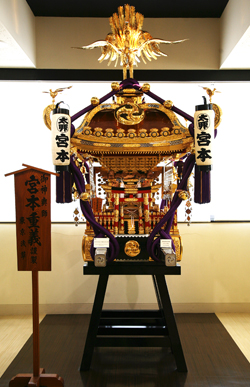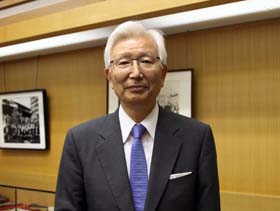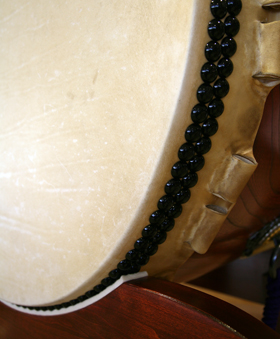
Nishi-asakusa Store, Miyamoto Unosuke Shoten
Q : What made you start making Japanese drums in Asakusa?
My forefather originally came from Tsuchiura, Ibaraki Prefecture. Our drum store opened in Asakusa Shoden-cho (present-day Asakusa 6-chome) in 1893. At that time, there were 6-7 drum stores around here.
Q : Is it because Asakusa Saruwaka-cho is situated nearby?
Yes, there was "Saruwaka Sanzas," or three Kabuki theaters in Saruwaka-cho. In addition to Saruwaka Sanzas, there were many leather dealers around here, so the drum stores opened in this area. Unosuke, the 4th descendant of the founder, transported tools for making drums by ship from Tsuchiura, and came to this place. Then, he was appointed to make Japanese ceremonial court music instruments used for the Imperial funeral of the Taisho Emperor. It was shortly after he opened the store in Asakusa. (continued in the lower column)

Q : The caption under the picture displayed behind you reads, "around 1930." Did your store mainly make drums?
We only made drums because this is a drum store. We began to make portable shrines around 1933. Although it is not displayed here, there is a picture of a float with only drums put on it, which was shot around 1930. That float was designed by the 5th descendant of the founder. As to festivals in the Edo Period, parishioners of a shrine carried 1-3 portable shrines, and each town pulled a tall float called Edo-type float. For example, Kanda and San-no Festivals are called "Tenka Festival," or world festival. In the Edo Period, floats pulled in those festivals were allowed to enter the Edo Castle. In short, Kanda and Hie Shrines were under the protection of the Edo Castle. Therefore, 40 towns' floats were pulled to enter the Edo Castle, and viewed by Tokugawa shoguns.
Those floats were taller than a height of the castle gate, so the floats had a three-layered structure. It was wisdom. When the floats were entered to the castle, images of, for example, Yoshitsune, the Sun Goddess, or Momotaro was put on top of the floats.
However, power lines were run throughout Tokyo in the middle of Meiji Period. The Edo Period was an era of candles, but the Meiji Period was of electricity, so tall floats could not be pulled around in Tokyo. Therefore, an official announcement that tall floats should not be used was issued. For that reason, we began to make drums with platform trucks pulled by children. At that time, portable shrines were owned only by shrines throughout the country. Town associations in Tokyo did not have portable shrines. However, large floats were banned from being pulled in Tokyo, so town associations began to use portable shrines. Consequently, there have been full of portable shrines in Tokyo. At first, we did not make portable shrines, and only made floats. However, we were asked by customers to make portable shrines, so we began to make portable shrines, drums and floats.
Q : Instruments for Japanese ceremonial court music are displayed at the store front. In addition to drums, do you deal with ceremonial court music instruments?
We are making many ceremonial court music instruments. If ceremonial court music instruments are used in annual festivals of shrines or wedding ceremonies, degree of formality is enhanced. If ceremonial court music is played instead of beating drums, a ceremony looks very fine.
Q : When buried cables increase, are old-style portable shrines likely to revive?
I think portable shrines will not get bigger because there is the limitation in the size of portable shrines that can be shouldered. Portable shrines up to 4 shaku (approximately 120 cm) can be shouldered. Their shapes have not changed much. Yet physical strength of bearers has changed. (continued in the right column)
My forefather originally came from Tsuchiura, Ibaraki Prefecture. Our drum store opened in Asakusa Shoden-cho (present-day Asakusa 6-chome) in 1893. At that time, there were 6-7 drum stores around here.
Q : Is it because Asakusa Saruwaka-cho is situated nearby?
Yes, there was "Saruwaka Sanzas," or three Kabuki theaters in Saruwaka-cho. In addition to Saruwaka Sanzas, there were many leather dealers around here, so the drum stores opened in this area. Unosuke, the 4th descendant of the founder, transported tools for making drums by ship from Tsuchiura, and came to this place. Then, he was appointed to make Japanese ceremonial court music instruments used for the Imperial funeral of the Taisho Emperor. It was shortly after he opened the store in Asakusa. (continued in the lower column)

Q : The caption under the picture displayed behind you reads, "around 1930." Did your store mainly make drums?
We only made drums because this is a drum store. We began to make portable shrines around 1933. Although it is not displayed here, there is a picture of a float with only drums put on it, which was shot around 1930. That float was designed by the 5th descendant of the founder. As to festivals in the Edo Period, parishioners of a shrine carried 1-3 portable shrines, and each town pulled a tall float called Edo-type float. For example, Kanda and San-no Festivals are called "Tenka Festival," or world festival. In the Edo Period, floats pulled in those festivals were allowed to enter the Edo Castle. In short, Kanda and Hie Shrines were under the protection of the Edo Castle. Therefore, 40 towns' floats were pulled to enter the Edo Castle, and viewed by Tokugawa shoguns.
Those floats were taller than a height of the castle gate, so the floats had a three-layered structure. It was wisdom. When the floats were entered to the castle, images of, for example, Yoshitsune, the Sun Goddess, or Momotaro was put on top of the floats.
However, power lines were run throughout Tokyo in the middle of Meiji Period. The Edo Period was an era of candles, but the Meiji Period was of electricity, so tall floats could not be pulled around in Tokyo. Therefore, an official announcement that tall floats should not be used was issued. For that reason, we began to make drums with platform trucks pulled by children. At that time, portable shrines were owned only by shrines throughout the country. Town associations in Tokyo did not have portable shrines. However, large floats were banned from being pulled in Tokyo, so town associations began to use portable shrines. Consequently, there have been full of portable shrines in Tokyo. At first, we did not make portable shrines, and only made floats. However, we were asked by customers to make portable shrines, so we began to make portable shrines, drums and floats.
Q : Instruments for Japanese ceremonial court music are displayed at the store front. In addition to drums, do you deal with ceremonial court music instruments?
We are making many ceremonial court music instruments. If ceremonial court music instruments are used in annual festivals of shrines or wedding ceremonies, degree of formality is enhanced. If ceremonial court music is played instead of beating drums, a ceremony looks very fine.
Q : When buried cables increase, are old-style portable shrines likely to revive?
I think portable shrines will not get bigger because there is the limitation in the size of portable shrines that can be shouldered. Portable shrines up to 4 shaku (approximately 120 cm) can be shouldered. Their shapes have not changed much. Yet physical strength of bearers has changed. (continued in the right column)
Fukutoku Shrine was just moved to the back of the COREDO Muromachi in Nihonbashi. The shrine, which was originally located on top of the building, was dismantled and built right behind the COREDO. We made portable shrines for the shrine. We have also made distinctive portable shrines tailored to each shrine. I think, although it might be inappropriate to use the term "town revitalization" in relation to the shrine, such kind of town revitalization is necessary. If there are not shrines, towns will be inorganic and occupied by shopping arcades with no spiritual pillar.
Q : What about demand for drums made in Japan?
Well, a performance called "Kumi-daiko," or ensemble drumming, began to be played about 50 years ago. Before that, drums were accompanying instruments for Japanese ceremonial court music, Noh, Kabuki, folk art and local Kagura performances, but Kumi-daiko, a new style, in which only a group of drums are played, emerged. It has spread not only all over Japan but also the world as "Wadaiko," or Japanese drums. It has quickly become popular in America in the same way as Sushi. Now, there are 200-300 teams of Kumi-daiko in cities of the West Coast, including San Francisco, Los Angeles and San Jose. Also, there are Kumi-daiko teams in Europe, mainly in England. It began to gain popularity among people in those cities about 40 years ago. Of course, there are Kumi-daiko teams in cities of the East Coast, including Boston and New York, but it is more actively performed in the West Coast. In Europe, it is mainly performed in England and France.
Q : Are their drumming style and method the same as that of Japanese?
Their style and method are same. In short, any drum can produce only two types of sound: "Bum" and "Ka." It is simple. A drum is played by combining them, so it is not possible to make unusual sound. The important thing is to create pleasant rhythm, so there are not major differences. Differences can only be made with how fast a drum is beaten, how frequent its edge is beaten, and how strong it is beaten. European people tend to see Kumi-daiko as art, and American people as a hobby.
Q : At present, how many people play Japanese drums?
Although I cannot calculate the number, I guess there are tens of thousands of Japanese drum players. Japanese drums are played by many people, including those who belong to groups that are active in regions, enjoy drumming as a bobby, and are professional drummers. A characteristic of Japanese drums is that the sound is very clear and loud because thick drumheads are mounted on hollowed wood bodies. The sound of Japanese drums is louder than that of Jazz drums. Many people are captivated by Japanese drums when they listen to the sound.
Q : Do you receive orders from overseas?
Some drum makers produce barrel drums. We provided a complete set of Japanese drums to Stanford University last year. The number of drums shipped abroad has increased.
Q : Have you ever made customized drums with unique shapes?
Although it is well-known today, there is "Katsugi Oke Do-taiko," or drum that is hung from a player's shoulder and beaten. Its price is reasonable, so many people privately purchase and practice on it. We also run a studio, so there are some people who practice playing special drums.

Q : What about demand for drums made in Japan?
Well, a performance called "Kumi-daiko," or ensemble drumming, began to be played about 50 years ago. Before that, drums were accompanying instruments for Japanese ceremonial court music, Noh, Kabuki, folk art and local Kagura performances, but Kumi-daiko, a new style, in which only a group of drums are played, emerged. It has spread not only all over Japan but also the world as "Wadaiko," or Japanese drums. It has quickly become popular in America in the same way as Sushi. Now, there are 200-300 teams of Kumi-daiko in cities of the West Coast, including San Francisco, Los Angeles and San Jose. Also, there are Kumi-daiko teams in Europe, mainly in England. It began to gain popularity among people in those cities about 40 years ago. Of course, there are Kumi-daiko teams in cities of the East Coast, including Boston and New York, but it is more actively performed in the West Coast. In Europe, it is mainly performed in England and France.
Q : Are their drumming style and method the same as that of Japanese?
Their style and method are same. In short, any drum can produce only two types of sound: "Bum" and "Ka." It is simple. A drum is played by combining them, so it is not possible to make unusual sound. The important thing is to create pleasant rhythm, so there are not major differences. Differences can only be made with how fast a drum is beaten, how frequent its edge is beaten, and how strong it is beaten. European people tend to see Kumi-daiko as art, and American people as a hobby.
Q : At present, how many people play Japanese drums?
Although I cannot calculate the number, I guess there are tens of thousands of Japanese drum players. Japanese drums are played by many people, including those who belong to groups that are active in regions, enjoy drumming as a bobby, and are professional drummers. A characteristic of Japanese drums is that the sound is very clear and loud because thick drumheads are mounted on hollowed wood bodies. The sound of Japanese drums is louder than that of Jazz drums. Many people are captivated by Japanese drums when they listen to the sound.
Q : Do you receive orders from overseas?
Some drum makers produce barrel drums. We provided a complete set of Japanese drums to Stanford University last year. The number of drums shipped abroad has increased.
Q : Have you ever made customized drums with unique shapes?
Although it is well-known today, there is "Katsugi Oke Do-taiko," or drum that is hung from a player's shoulder and beaten. Its price is reasonable, so many people privately purchase and practice on it. We also run a studio, so there are some people who practice playing special drums.


Nishi-asakusa Store, Miyamoto Unosuke Shoten






